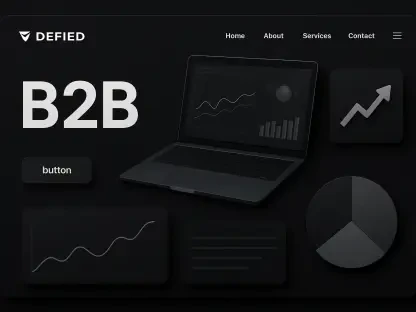Dive into the world of marketing analytics with Anastasia Braitsik, a globally recognized leader in SEO, content marketing, and data analytics. With her deep expertise, Anastasia has helped countless businesses navigate the complexities of modern customer journeys through innovative attribution modeling. In this engaging conversation, we explore the evolution of attribution models, moving beyond outdated methods like last-click to more nuanced approaches such as multitouch and data-driven attribution. We’ll unpack the strengths and limitations of various models, discuss their relevance to B2B marketing, and uncover strategies for choosing the right approach to maximize marketing ROI. Join us as Anastasia shares actionable insights and real-world examples to help marketers better understand and influence their customers’ paths to purchase.
Can you walk us through what last-click attribution is and why it gained so much traction in the early days of marketing analytics?
Last-click attribution is a model that gives full credit for a conversion to the very last interaction a customer had with a brand before making a purchase—think a final click on an ad or a direct visit to a website. It became popular early on because it’s incredibly straightforward to track. Back when analytics tools were just taking off, platforms needed a simple way to measure impact, and last-click was built into many of them as the default. It didn’t require complex data processing or deep integration across channels; it just pointed to the final touchpoint and said, “This did it.” That simplicity made it a go-to for marketers who were just starting to dip their toes into digital measurement.
Why do you think last-click attribution struggles to keep up with today’s marketing landscape, especially for B2B companies?
Last-click really falls short in today’s world because customer journeys, particularly in B2B, are rarely a straight line. Buyers don’t just click one ad and sign a contract—they’re researching over weeks or months, attending webinars, reading content, and engaging with sales teams. Last-click ignores all those earlier touchpoints that shape the decision, focusing only on the final step. For B2B, where multiple stakeholders are often involved and the sales cycle is long, this means you’re missing out on understanding critical interactions like initial awareness campaigns or mid-funnel nurturing efforts. It’s like judging a whole movie by just the last scene—you lose the full story.
How would you describe multitouch attribution, and why does it offer a better lens for understanding modern customer behavior?
Multitouch attribution is about recognizing that every interaction along a customer’s journey plays a role in the final outcome. Unlike last-click, it distributes credit across various touchpoints—whether it’s the first ad they saw, a blog post they read, or a late-stage demo. This approach fits modern behavior because customers are bouncing between channels, devices, and platforms. For marketers, it paints a clearer picture of how each piece of the puzzle contributes, so you’re not blindly overvaluing one channel. It’s especially powerful in B2B, where you can see how different content or engagements influence multiple decision-makers over time.
Can you share a story or example of how adopting multitouch attribution has transformed a business’s marketing strategy?
Absolutely. I worked with a B2B software company that was stuck on last-click and pouring budget into late-stage ads because that’s what seemed to “close” deals. When we switched to a multitouch model, they saw that early-stage content—like blog posts and webinars—was actually sparking a lot of initial interest and influencing decisions way more than they thought. By reallocating some budget to beef up that top-of-funnel content, they boosted qualified leads by about 25% in just a few months. It was a game-changer because they stopped undervaluing the early journey and started building trust with prospects from the get-go.
Let’s dive into data-driven attribution. How does it stand apart from more traditional rule-based models like last-click or first-click?
Data-driven attribution is a step up because it doesn’t rely on rigid, predefined rules like “credit the last touch” or “credit the first touch.” Instead, it uses algorithms and historical data to figure out the actual impact of each interaction on a conversion. It’s dynamic—it looks at patterns in real customer behavior and adjusts credit based on what’s truly driving results. This makes it far more accurate for complex journeys because it’s not guessing or following a one-size-fits-all formula; it’s tailored to the unique ways your audience engages with your brand.
What challenges or requirements come with implementing data-driven attribution effectively?
The biggest hurdle with data-driven attribution is that it demands a solid foundation of data and the right tools to analyze it. You need clean, comprehensive data across all your channels—website visits, ad clicks, email opens, everything. Without that, the algorithms can’t do their job. You also need advanced analytics platforms that can handle this kind of modeling, which can be a significant investment. But once you’ve got that setup, the insights are worth it because you’re not just following assumptions—you’re acting on what the numbers actually tell you about your customers.
When do you think a business should consider using first-click attribution, and what value does it bring to the table?
First-click attribution, which credits the very first interaction a customer has with your brand, is most useful when you’re laser-focused on understanding top-of-funnel efforts. If your goal is to figure out which channels or campaigns are driving initial awareness and bringing new prospects into your pipeline, this model shines. It’s great for assessing things like display ads or social media campaigns meant to get eyes on your brand. It helps you see what’s sparking that first interest, which is critical for building a strong foundation in your marketing strategy.
What are some of the pitfalls of relying solely on first-click attribution, particularly in longer sales cycles?
The downside of first-click is that it completely ignores everything that happens after that initial interaction. In longer sales cycles, like in B2B, where nurturing and closing can take months, this is a big problem. You might overinvest in awareness channels while neglecting the mid- and late-stage touchpoints—like targeted emails or sales consultations—that actually turn leads into customers. It’s like praising the person who opened the door but forgetting everyone who guided the guest through the house. You risk skewed priorities and missed opportunities to optimize the full journey.
Could you explain time-decay attribution and why it might be a good fit for certain types of marketing campaigns?
Time-decay attribution assigns credit to touchpoints based on how close they are to the final conversion, giving more weight to later interactions. So, an ad clicked a day before a purchase gets more credit than a blog post read a month earlier. It’s a good fit for campaigns focused on driving conversions quickly, especially when late-stage interactions like demos or free trials are often the tipping point. It highlights what’s pushing prospects over the finish line, which can be really helpful for optimizing those final nudges in shorter or more urgent campaigns.
How might undervaluing early touchpoints with time-decay attribution impact a marketing strategy over the long term?
When time-decay undervalues early touchpoints, you can end up shortchanging the channels that build awareness and trust in the first place. If you’re not giving enough credit to things like initial ads or content that get people into your funnel, you might cut back on those efforts. Over time, that can shrink your pipeline because fewer prospects are entering the journey. It’s a slow burn—you might not notice the impact right away, but eventually, you’re left wondering why your lead volume is drying up. Balancing time-decay with other models can help avoid that blind spot.
What advice would you give to businesses trying to select the right attribution model for their specific goals and challenges?
My advice is to start with a clear understanding of what you’re trying to achieve. Are you focused on building brand awareness? Then something like first-click might give you the insights you need. Want to drive conversions? Look at time-decay or data-driven models. Consider your sales cycle length and how much data you can access—longer cycles and complex journeys often need multitouch or data-driven approaches. Don’t just pick one and stick with it forever; test different models against your key metrics to see which reflects your customer behavior best. And remember, it’s not always about one perfect model—sometimes combining insights from a couple of them gives you the sharpest view. Keep experimenting and refining as your audience and goals evolve.









